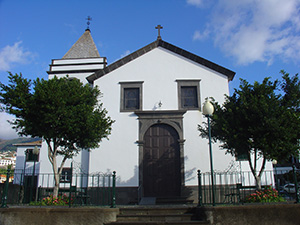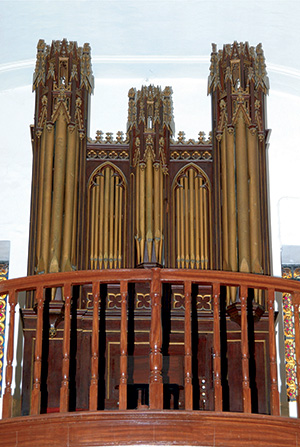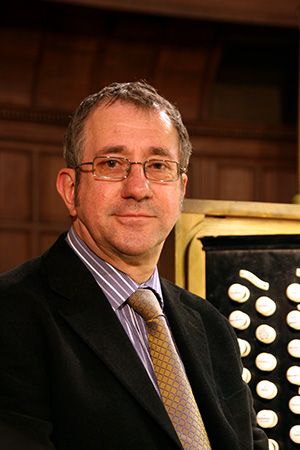 Friday, 25 October, 9.30, p.m.
Friday, 25 October, 9.30, p.m.
Church of Santa Luzia
John Kitchen: organ
The Fantazia of foure parts is Gibbons’s finest keyboard work, published in 1612/13 in the celebrated collection Parthenia, ‘the first musicke that ever was printed for the Virginalls’. It is a substantial movement, which skilfully works six points of imitation in turn, becoming more animated as it progresses, but ending solemnly as it begins.
The Voluntary in D minor by Henry Purcell has come down to us in two forms: one for performance on a single manual instrument (which we hear today) and one for ‘double organ’, that is, with two manuals. The piece is notably flamboyant, and ‘baroque’ in the true sense. The first section of the Voluntary in G, with its slowly-moving chromatic chords, owes something to Frescobaldi’s durreze e ligature style; this is followed by a brisk canzona-like section.
Stanley was one of the most celebrated London organists of his time. Today we hear one of the organ concertos, a genre which had been established in London by Handel. Stanley’s concertos appeared in 1775 in a form which allowed either performance with string orchestra or as a solo keyboard piece. The C minor concerto is generally regarded as the finest; it shows Stanley moving away from the Handelian style towards the galant idioms of J.C. Bach and others.
William Russell published two sets of organ voluntaries, each containing twelve: the first in 1804 and the second in 1812, just a year before his untimely death. Russell’s music—still little-known— is always engaging, colourful, full of vigour and sometimes truly arresting. In the Voluntary no. X in G minor (1804), the short larghetto sets the scene for a vigorous fugue whose fine subject makes much of the interval of a seventh, and which is skilfully and pleasingly developed. The Voluntary no. VII in A (1812) is a pastoral two-movement work, beginning with a rather rustic siciliano rustic flavour. The allegretto moderato, played on a light chorus, is beautifully poised and elegant. The Voluntary no IX in B flat is in the form of a grand prelude, followed by a robust fugue which is reminiscent of Haydn’s chorus ‘Achieved is the glorious work’ from The Creation,a movement which would have been well-known to Russell.
The celebrated Air and Gavotte are the best movements from Samuel Wesley's Twelve Short Pieces (actually thirteen!) of 1816. They are charming and elegant, of no great pretension. Sebastian (Samuel’s illegitimate son) is represented by the Andante in E flat, dating from the 1870s, is in a fully-developed Romantic style, owing something to Mendelssohn but also showing signs of Sebastian's characteristic quirkiness.
Handel himself made keyboard arrangements of some of his overtures, although not Samson, which was one of a number published by John Walsh; it is a splendid overture. The vigorous opening andante is in triple time and in two repeated sections; a short adagio cadenza leads into an energetic fugue (partly based on Telemann and Muffat). Handel concludes with an elegant minuet in ABA form, its germ borrowed from Reinhard Keiser, but, in the words of Winton Dean, “improved and developed...beyond measure”.
John Kitchen
Orlando Gibbons (1583-1625)
Fantazia of foure parts (Parthenia)
Henry Purcell (1659-1695)
Voluntary in D minor
Voluntary In G major
John Stanley (1712–1786)
Concerto no. 4 in C minor, Op. 10
Vivace
Andante affetuoso
Presto
William Russell (1777–1813)
Voluntary VII in A major (1812)
Siciliano
Allegretto moderato
Voluntary IX in B flat major
Maestoso
Allegro
Samuel Wesley (1766–1837)
Air
Gavotte (Twelve Short Pieces, 1816)
Georg Friedrich Haendel (1685–1759)
Overture from Samson
Andante
Allegro
Minuet
Participants
|
John Kitchen was educated at the Universities of Glasgow and Cambridge, and in 1976 took up the post of Lecturer in Music and University Organist at the University of St Andrews in Scotland. Since 1988 he has been a Senior Lecturer in Music and University Organist in the University of Edinburgh. He also directs the Edinburgh University Singers, is Director of Music of Old Saint Paul’s Episcopal Church and Edinburgh City Organist with duties at the Usher Hall. He gives many solo recitals both in the UK and further afield, and also plays regularly with several ensembles, covering a wide range of musical styles. In addition, he is much in demand as a continuo player, accompanist, lecturer, adjudicator, writer and reviewer. John Kitchen has made many recordings for both Priory and for the Edinburgh-based label Delphian Records. These include a highly-acclaimed account of the complete organ music of William Russell, played on the 1829 Bishop organ in St James’s, Bermondsey in London, and a CD of Handel overtures and suites played on two of the harpsichords from the world-famous Raymond Russell Collection of Early Keyboard Instruments, housed at St Cecilia’s Hall in the University of Edinburgh. |
Notes about the Organ
 Church of Santa Luzia
Church of Santa Luzia
According to the register of expenses for the years 1839 to 1841, we find that remunerations were given to the singers and organists (ARM Confraria: L.º n.º 44: 44-45), which straight away implies that the Church of Santa Luzia already had a pipe organ, probably of some considerable age, before it was replaced by the arrival of the instrument from the dissolved Convent of São Francisco. This second organ was acquired in 1834. However, it was only moved to the Church of Santa Luzia in 1842, according to the register of Father Joaquim António Português who, on 15 January of that year, noted down in the Accounts Book, an extra sum to pay for it to be transported definitively to the church: “50,000 réis which I gave to the man who arranged for the São Francisco organ to be brought to this parish, since he had received nothing, owing to the decease of Brother António das Dores, who was to have dealt with this.” (MATOS 1996: 16).
In the course of the 20th century, this instrument was subject to frequent maintenance work, paid for by donations from various members of the parish. According to the Accounts Book, on 20 December 1902 the organ was repaired for the sum of 300$00 (réis?), the expense being met by Mr. Augusto Camarrinha, resident at Pará (MATOS 1996: 44); in 1936 and 1940 320$00 and 150$00 (escudos), respectively were spent, for repairs on two further occasions (Matos 1996: 88). In 1950, at the time of work done to the floor and gallery, and again in 1963, repairs, inadequately carried out, were undertaken by António Gomes Jardim, who was from Ribeiro da Janela.
It has not been possible to identify the maker of the organ. Manuel Valença (1997:59) describes it as a “positive organ made in England with very specific characteristics – just one manual, with seven stops throughout the range and three divided, considered, of its type, one of the best in the Diocese “ and Christopher Kent, of the Music Department of Reading University, England, records it as having been made in England, dating it, following an inscription found on the pipes, to 1815-1820. He adds that it is “one of the famous organs, like certain others of the same make, which are to be found in England.” (MATOS 1996: 16). It was restored in 2013 by Dinarte Machado.
Registration
Open Diapason 8’
Stop Diapason (GG-b)
Stop Diapason (c’-f’’’)
Bourdon 8’ (GG-b)
Flute 4’ (c’-f’’’)
Principal 4’
Fifteenth 2’
Cornet (GG-b)
Sesquialtera (c’-f’’’)
Trumpet (f’-f’’’)
 John Kitchen
John Kitchen